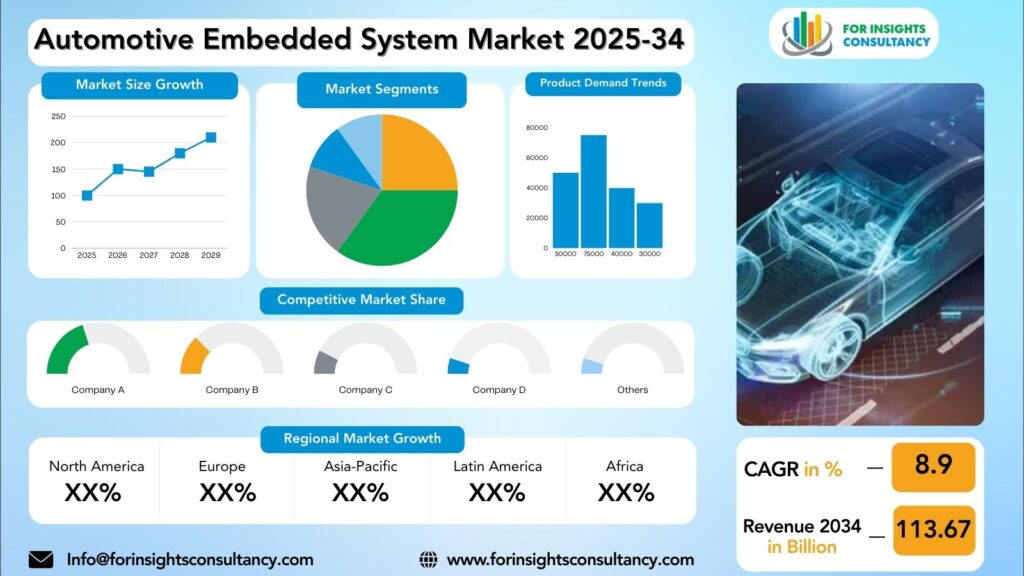
Automotive Embedded System Market Research Report by Application (Infotainment & Telematics, Powertrain Electronics, Safety & Security, Body Electronics, Advanced Driver-Assistance Systems (ADAS)), by Component (Hardware, Software), by Vehicle Type (Passenger Car, Commercial Vehicle, Electric Vehicle (EV)), by Technology, and Region Global Market Analysis and Forecast, 2025-2034
Aug-2025 Formats | PDF | Category: Automotive | Delivery: 24 to 72 Hours
Automotive Embedded System Market is forecast to increase from USD 57.89 Billion in 2025 to USD 113.67 Billion by 2034, at a CAGR of 8.9%.
Automotive Embedded System Market: A Comprehensive Overview and Future Developments
Automotive embedded systems are computer systems integrated into vehicles to control various functions like engine management, infotainment, climate control, and safety features. These systems consist of hardware and software components that ensure smooth vehicle operation. The automotive embedded system market is expected to grow significantly in the coming years due to technological advancements and the increasing demand for smart, connected vehicles.
As more vehicles are equipped with advanced embedded systems, consumers can expect improved safety, convenience, and efficiency on the road. The market is a dynamic and rapidly evolving industry that plays a crucial role in shaping the future of transportation, with key players driving innovation and technological advancements.
Automotive Embedded System Market Dynamics
Growth Drivers
The automotive industry is experiencing a surge in demand for advanced driver-assistance systems (ADAS), electric and autonomous vehicles, vehicle connectivity and infotainment, energy efficiency and sustainability, and technological advancements in automotive embedded systems. The adoption of ADAS features such as adaptive cruise control, lane departure warning, and automatic emergency braking is a major driver of the growth of the automotive embedded system market. The shift towards electric and autonomous vehicles requires sophisticated embedded systems to power their advanced functionalities, such as battery management systems and self-driving algorithms.
The automotive industry is also focusing on vehicle connectivity and infotainment, enabling vehicles to connect to external networks, synchronize with smartphones, and offer personalized entertainment options. The rise of the Internet of Things (IoT) and smart devices is driving the demand for connected vehicles, and automotive embedded systems play a vital role in enabling this connectivity and enhancing the overall user experience.
The automotive industry is also focusing on energy efficiency and sustainability, with hybrid and electric vehicles being introduced to meet environmental standards. Automotive embedded systems play a crucial role in optimizing energy usage, managing power distribution, and enhancing the efficiency of these vehicles.
Technological advancements in automotive embedded systems are driving innovation and expanding the capabilities of modern vehicles, with real-time data processing and predictive maintenance becoming more sophisticated and intelligent. The continuous evolution of automotive embedded systems is propelling market growth and shaping the future of the automotive industry.
Restraints
The automotive embedded system market faces several challenges, including high costs associated with developing and deploying advanced technologies, the complexity of integration, security concerns, and regulatory compliance. The high cost of embedded systems, coupled with the need for frequent software updates and maintenance, makes it difficult for automakers to adopt these solutions on a large scale. The integration of software from multiple vendors further complicates the process, leading to delays in product development and testing.
Security concerns are also significant as vehicles become more connected and autonomous, increasing the threat of cyber-attacks and data breaches. Ensuring the security and integrity of embedded systems is crucial, as a single vulnerability can expose the entire vehicle to potential risks. Implementing robust security measures like encryption, authentication, and intrusion detection is essential to protect connected vehicles from malicious attacks and safeguard sensitive data.
Regulatory compliance is another significant challenge for automotive manufacturers and suppliers. Meeting requirements like ISO 26262 for functional safety and ISO 21434 for cybersecurity poses a significant risk to market access and companies, as failure to comply can result in legal liabilities and reputational damage.
Opportunities
The automotive embedded system market is driven by the rise of autonomous vehicles, the integration of IoT and connectivity features, the focus on user experience and infotainment, and the expansion of aftermarket solutions. As autonomous vehicles become more mainstream, the demand for advanced automotive embedded systems will increase, presenting lucrative opportunities for market players. The integration of IoT in vehicles allows for seamless communication between vehicles, infrastructure, and other devices, enhancing the overall driving experience and safety.
In-car infotainment systems are essential for providing a seamless and intuitive user experience, with automotive embedded systems powering features like touchscreens, voice recognition, navigation, and smartphone integration. As consumer preferences shift towards connected and personalized driving experiences, automakers will need to invest in advanced embedded systems to stay competitive.
The aftermarket segment presents promising opportunities for the automotive embedded system market, as vehicle owners upgrade their existing vehicles with innovative and customizable solutions. Aftermarket vendors play a key role in driving the adoption of automotive embedded systems beyond new vehicle purchases.
Challenges
The automotive embedded system market faces several challenges due to the increasing complexity of automotive electronics. As vehicles become more connected and autonomous, the number of electronic control units (ECUs) and lines of code in a car has significantly increased, making it difficult to develop and integrate new features. This complexity raises concerns about cybersecurity and system reliability. To address this, automakers and suppliers are investing in advanced software development tools and platforms, such as model-based design and simulation tools, and standardized communication protocols like CAN and Ethernet.
Another challenge is the shortening product lifecycles, as new features are introduced to vehicles at a faster rate. To overcome this, companies are adopting agile development methodologies and modular architectures, breaking down complex systems into smaller, manageable modules. Over-the-air (OTA) updates allow automakers to remotely update software in vehicles, extending their lifespan and improving user experience.
Regulatory requirements for automotive embedded systems are becoming increasingly stringent, with cybersecurity standards and data privacy regulations. Failure to meet these regulations can result in costly fines, lawsuits, and damage to the brand’s reputation.
Automotive Embedded System Market Top Companies Covered In This Report:
Evaluate The Strategic Positioning And Innovation Pipelines Of Leading Market Companies-From Multinational Enterprises To Disruptive Regional Firms. Understand How Key Players Are Innovating, Expanding, And Capturing Value, And Use Competitive Benchmarks To Plan Your Next Move.
- Panasonic
- Infineon Technologies
- Texas Instruments
- Renesas
- Analog Devices
- Qualcomm
- Hyundai Mobis
- NXP Semiconductors
- STMicroelectronics
- Continental AG
- Aptiv
- Robert Bosch
- NVIDIA
- DENSO
Automotive Embedded System Market News
Qualcomm
In mid-2025, Qualcomm announced plans to localize the production of its automotive modules in India, investing significantly to support domestic automakers like Tata Motors, Mahindra, and Hyundai. This move aims to cater to the specific needs of the local market.
NVIDIA1
In March 2025, General Motors (GM) and NVIDIA announced an expanded collaboration to use AI, simulation, and accelerated computing to design next-generation vehicles and optimize factory operations. GM will use NVIDIA DRIVE AGX platforms for future ADAS and in-vehicle systems.
Infineon Technologies
In late August 2025, Infineon announced a strategic initiative with NVIDIA to accelerate the development of humanoid robots. The collaboration integrates Infineon’s microcontrollers and sensors with NVIDIA’s Jetson Thor platform to deliver an integrated and scalable solution for robotics, with potential for cross-application in the automotive space.
Segmented View of the Industry:
The Automotive Embedded System Market Is Mapped Through A Multidimensional Lens-Tracking Shifts Across Product Type, Applications, And Geographic Regions. This Segmented Approach Enables Businesses To Localize Their Growth Plans And Align Offerings With The Most Profitable Demand Centers.
Segmentation by Vehicle Type
- Electric Vehicle (EV)
- Passenger Car
- Commercial Vehicle
Segmentation by Component
- Hardware
- Software
Segmentation by Application
- Infotainment & Telematics
- Powertrain Electronics
- Safety & Security
- Body Electronics
- Advanced Driver-Assistance Systems (ADAS)
Segmentation by Technology
- Artificial Intelligence (AI)
- Internet of Things (IoT)
- Machine Learning
- Cloud Computing
- Edge Computing
Global Geographic Coverage:
The Report Provides In-Depth Qualitative and Quantitative Data On the Automotive Embedded System Market For All Of The Regions And Countries Listed Below:
North America
The automotive embedded system market is expanding in the United States, Canada, and Mexico due to the increasing demand for connected cars and autonomous vehicles. The US automakers are integrating advanced embedded systems to enhance safety, efficiency, and connectivity. Canada’s growing automotive industry is also contributing to the market expansion, with automakers adopting advanced features like infotainment, driver assistance, and telematics. Mexico is emerging as a key player in the market, with a rise in vehicle production and technological advancements. Mexican automakers are investing in embedded systems to improve vehicle performance, safety, and efficiency. The growing collaboration between international automotive companies and local manufacturers is driving the growth of the embedded system market in Mexico.
Europe
The United Kingdom (UK) is a significant player in the European automotive industry, with a focus on innovation and research. It is home to leading automotive manufacturers like Jaguar Land Rover and Aston Martin, and the demand for advanced embedded systems in vehicles is on the rise. The increasing adoption of electric vehicles and autonomous driving technologies is also driving growth in the automotive embedded system market in the UK.
Germany, known for its high-quality automotive engineering, is a hub for automotive innovation. Major automakers like Volkswagen, BMW, and Mercedes-Benz are at the forefront of integrating advanced embedded systems into their vehicles. The growing emphasis on smart mobility solutions, such as connected cars and autonomous vehicles, is fueling the demand for cutting-edge embedded systems in the German automotive market.
France, with a rich automotive history, is a significant market for embedded systems in the automotive industry. Companies like Renault and Peugeot are driving innovation in smart and connected vehicles. The French automotive market is witnessing a shift towards electric and hybrid vehicles, leading to an increased demand for advanced embedded systems that can support these technologies. With a focus on sustainability and environmental conservation, France is poised to play a vital role in shaping the future of the automotive embedded system market in Europe.
Asia Pacific
China, Japan, India, and South Korea are major players in the Automotive Embedded Systems market in the Asia Pacific region. China’s robust automotive industry and technological advancements are driving the market’s growth, with a growing demand for connected vehicles and smart electronic systems. Japan’s strong manufacturing base and focus on safety, efficiency, and connectivity are driving the adoption of embedded systems in vehicles. India’s growing economy, rising disposable income, and increasing demand for connected vehicles are fueling market growth.
Government initiatives promoting electric mobility and digital connectivity are driving the adoption of embedded systems in the automotive sector. South Korea, a key hub for automotive technology in the Asia Pacific, is home to major automotive electronics manufacturers and research institutes, driving innovation in the market. The adoption of advanced driver assistance systems and connected vehicle technologies is driving market growth in the country.
Middle East and Africa
The UAE is leading the way in adopting smart transportation solutions, driving the demand for automotive embedded systems. Key players in the UAE include Bosch, Continental, and Harman International. Saudi Arabia is experiencing a surge in automotive embedded system adoption due to the government’s Vision 2030 initiative and investments in smart city infrastructure. Companies like Denso, Delphi Technologies, and Panasonic are actively participating in the Saudi market. Qatar’s automotive industry is rapidly transforming with the integration of advanced technologies like IoT, AI, and machine learning. Leading players like Aptiv, Visteon, and ZF Friedrichshafen are capitalizing on this growth trend.
South Africa’s automotive sector is at the forefront of technological innovation, with a strong focus on digitalization and connectivity. Major players like Infineon Technologies, NXP Semiconductors, and Robert Bosch are expanding their presence in the South African market. Nigeria’s automotive industry is shifting towards smart mobility solutions, driven by rapid urbanization and growing middle-class population. Companies like Autoliv, Renesas Electronics, and Texas Instruments are seizing opportunities in the Nigerian market.
Kenya is emerging as a key market for automotive embedded systems, driven by the government’s initiatives to promote electric mobility and sustainable transportation. Leading players like Continental AG, Magna International, and Valeo are engaging with local partners to expand their foothold in the country.
Reasons to Buy:
- The Research Would Help Top Administration/Policymakers/Professionals/Product Advancements/Sales Managers And Stakeholders In This Market In The Following Ways.
- The Report Provides Automotive Embedded System Market Revenues At The Worldwide, Regional, And Country Levels With A Complete Analysis To 2034 Permitting Companies To Analyze Their Market Share And Analyze Projections, And Find New Markets To Aim For.
- To Understand The Most Affecting Driving And Restraining Forces In The Market And Their Impact On The Global Market.
- Major Changes And Assessment In Market Dynamics And Developments.
- The Objective Of The Automotive Embedded System Market Report Is To Identify New Business Opportunities Using Quantitative Market Forecasts.
- Formulate Sales And Marketing Strategies By Gaining An Understanding Of Competitors, Their Positioning, And Strengths & Weaknesses.
Faq – What Global Leaders Are Asking
What Is The Growth Prospect For The Automotive Embedded System Market By 2034?
Automotive Embedded System Market Is Expected To Achieve A Stable Growth Rate With A Compound Annual Growth Rate (Cagr) Of About 8.9% From 2025 Through 2034.
What Is Driving The Growth Of The Automotive Embedded System Market?
The market’s growth is driven by the rise of Advanced Driver-Assistance Systems (ADAS), infotainment, and other in-vehicle electronics that enhance safety and user experience. This is further fueled by the industry’s shift towards electric and autonomous vehicles, which are fundamentally built on sophisticated embedded systems.
Who Are The Key Players In The Automotive Embedded System Market, And What Are Their Market Shares?
The Automotive Embedded System Market Includes Major Companies Like Panasonic, Infineon Technologies, Texas Instruments, Renesas, Analog Devices, Qualcomm, Hyundai Mobis, NXP Semiconductors, STMicroelectronics, Continental AG, Aptiv, Robert Bosch, NVIDIA, DENSO.
Specific Market Share Data Is Not Publicly Available and Is Typically Provided In Detailed, Proprietary Market Research Reports.
Which Regions Are Leading the Automotive Embedded System Market Growth?
North America leads the automotive embedded systems market due to the presence of major manufacturers and a high adoption rate of advanced technologies like ADAS and connected vehicles. Meanwhile, the Asia-Pacific region is the fastest-growing market, driven by rising vehicle production and increasing demand for feature-rich cars in emerging economies like China and India.
Customization: We Can Provide Following Things
1) On Market More Company Profiles (Competitors)
2) Data About Particular Country Or Region
3) We Will Incorporate The Same With No Additional Cost (Post Conducting Feasibility).
Any Requirement Contact Us: Https://Www.Forinsightsconsultancy.Com/Contact-Us/
Table of Contents
For TOC Contact us: https://forinsightsconsultancy.com/contact-us/







